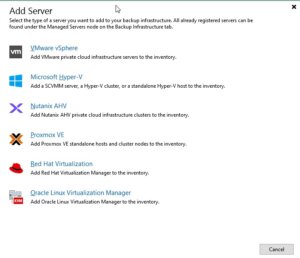On Thursday, 26 June and Friday, 27 June 2025, my colleague Patrick Lauer and I had the amazing opportunity to attend Swiss PGDay 2025, held at the OST Eastern Switzerland University of Applied Sciences in Rapperswil. This two-day PostgreSQL conference featured two parallel tracks of presentations in English and German, bringing together users and experts primarily from across Switzerland. Our company, credativ, was among the supporters of this year’s conference.
During the event, Patrick delivered an engaging session titled “Postgres with many data: To MAXINT and beyond,” which built on past discussions about massive-scale Postgres usage. He highlighted the practical issues that arise when handling extremely large datasets in PostgreSQL – for instance, how even a simple SELECT COUNT(*) can become painfully slow, and how backups and restores can take days on very large datasets. He also shared strategies to manage performance effectively at these scales.
I presented a significantly updated version of my talk, “Building a Data Lakehouse with PostgreSQL: Dive into Formats, Tools, Techniques, and Strategies.” It covered modern data formats and frameworks such as Apache Iceberg, addressing key challenges in lakehouse architectures – from governance, privacy, and compliance, to data quality checks and AI/ML use cases. The talk emphasized PostgreSQL’s capability to play a central role in today’s data lakehouse and AI landscape. At the close of the conference, I delivered a brief lightning talk showcasing our new open-source migration tool, “credativ-pg-migrator.”
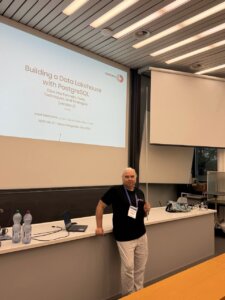
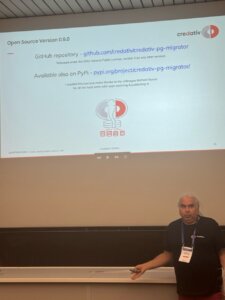
(c) photos by Gülçin Yıldırım Jelinek
The conference schedule was packed with many high-quality, insightful talks. We would particularly like to highlight:
* Bruce Momjian – “How Open Source and Democracy Drive Postgres”: In his keynote, Bruce Momjian outlined how PostgreSQL’s open-source development model and democratic governance have powered its success. He explained the differences between open-source and proprietary models, reviewed PostgreSQL’s governance history, and illustrated how democratic, open processes result in robust software and a promising future for Postgres.
* Gülçin Yıldırım Jelinek – “Anatomy of Table-Level Locks in PostgreSQL”: session covered the fundamentals of PostgreSQL’s table-level locking mechanisms. Explained how different lock modes are acquired and queued during schema changes, helping attendees understand how to manage lock conflicts, minimize downtime, and avoid deadlocks during high-concurrency DDL operations.
* Aarno Aukia – “Operating PostgreSQL at Scale: Lessons from Hundreds of Instances in Regulated Private Clouds”: the speaker shared lessons from running extensive Postgres environments in highly regulated industries. He discussed architectural patterns, automation strategies, and “day-2 operations” practices that VSHN uses to meet stringent availability, compliance, and audit requirements, including secure multi-tenancy, declarative deployments, backups, monitoring, and lifecycle management in mission-critical cloud-native setups.
* Bertrand Hartwig-Peillon – “pgAssistant”: Author introduced pgAssistant, an open-source tool designed to help developers optimize PostgreSQL schemas and queries before production deployment. He demonstrated how pgAssistant combines deterministic analysis with an AI-driven approach to detect schema inconsistencies and suggest optimizations, effectively automating best practices and performance tuning within development workflows.
* Gianni Ciolli – “The Why and What of WAL”: Gianni Ciolli provided in a great Italian style concise history and overview of PostgreSQL’s Write-Ahead Log (WAL). He explained WAL’s central role in PostgreSQL for crash safety, backups, and replication, showcasing examples of WAL-enabled features like fast crash recovery, efficient hot backups, physical replication, and logical decoding.
* Daniel Krefl – “Hacking pgvector for performance”: The speaker presented an enhanced version of the pgvector extension for massive data processing, optimized by maintaining the vector index outside PostgreSQL memory and offloading computations, including GPU integration. He detailed the process of moving pgvector’s core logic externally for improved speed, demonstrating notable performance gains in the EU AERO project context. He also talked about distributed PostgreSQL XC, XL and TBase, which are unfortunately stuck on the old version 10 and how he ported changes from these projects into the version 16.
* Luigi Nardi – “A benchmark study on the impact of PostgreSQL server parameter tuning”: Luigi Nardi presented comprehensive benchmark results on tuning PostgreSQL configuration parameters. Highlighting that many users default settings, he demonstrated how significant performance improvements can be achieved through proper tuning across various workloads (OLTP, OLAP, etc.), providing actionable insights tailored to specific environments.
* Renzo Dani – “From Oracle to PostgreSQL: A HARD Journey and an Open-Source Awakening”: Author recounted his experiences migrating a complex enterprise application from Oracle to PostgreSQL, addressing significant challenges such as implicit type casting, function overloading differences, JDBC driver issues, and SQL validation problems. He also highlighted the benefits, including faster CI pipelines, more flexible deployments, and innovation opportunities provided by open-source Postgres, along with practical advice on migration tools, testing strategies, and managing trade-offs.
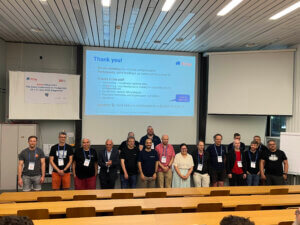
(c) photo by Swiss PostgreSQL User Group
At the end of the first day, all participants enjoyed a networking dinner. We both want to sincerely thank the Swiss PGDay organizers (Swiss PostgreSQL User Group) for an amazing event. Swiss PGDay 2025 was a memorable and valuable experience, offering great learning and networking opportunities. We are also very grateful to credativ for enabling our participation, and we look forward to future editions of this excellent conference.
From March, 1st 2025, the Mönchengladbach-based open source specialist credativ IT Services GmbH will once again operate as an independent company on the market. credativ GmbH was acquired by NetApp in May 2022 and integrated into NetApp Deutschland GmbH on February, 1st 2023. This step enabled the company to draw on extensive experience and a broader resource base. However, after intensive collaboration within the storage and cloud group, it has become clear that credativ can offer the best conditions for addressing the needs of its customers in an even more targeted manner thanks to its regained independence. The transfer of operations will be supported by all 46 employees.
“We have decided to take this step to focus on our core business areas and create the best possible conditions for further growth. This means maximum flexibility for our customers. We would like to thank the NetApp management for this extraordinary opportunity,‘ said David Brauner, Managing Director of credativ IT Services GmbH.
’The change is a testament to the confidence we have in the credativ team and their ability to lead the business towards a prosperous future,” explained Begoña Jara, Vice President of NetApp Deutschland GmbH here in Germany.
What does this change mean for credativ customers?
As a medium-sized company, the open source service provider can rely on even closer collaboration and more direct communication with its customers. An agile structure should enable faster and more customised decisions, and thus a more flexible response to requests and requirements. Naturally, the collaboration with the various NetApp teams and their partner organisations will also continue as before.
credativ has been a service provider in the open source sector since 1999, with a strong focus on IT infrastructure, virtualisation, and cloud technologies. credativ also has a strong team that focuses on open source-based databases, such as PostgreSQL, and related technologies. In the next few weeks, the new company will be renamed credativ GmbH.
The topic of AI “hallucinations” has gained considerable attention in discussions surrounding large language models (LLMs) and generative AI. Some view it as the most significant flaw of LLMs, undermining their usability. Yet others see it as a potential source of new ideas. Let us delve deeper into this issue. To understand this phenomenon, it is crucial to recognize that AI hallucinations are not intentional errors or bugs in the system. From the AI’s perspective, there is little distinction between what humans call a “hallucination” and a “correct” answer. Both types of output are produced by the same process: predicting the most probable response based on patterns in the training data. Large language models, such as GPT-4 and similar transformer-based architectures, are inherently probabilistic. They generate responses based on the most likely sequence of words (tokens) given the context of a conversation or query. This probability is derived from the patterns and structures learned from vast amounts of text during training. While the training data is extensive, it is far from perfect, containing gaps, biases, and inaccuracies. Nevertheless, LLMs are designed to always provide a response, even when uncertain.
Hallucinations typically arise from one of these issues: overgeneralization, underfitting, or overfitting. Overgeneralization often stems from problems in the training dataset. LLMs are designed to generalize based on patterns and associations learned from the data, but they can also generalize hidden errors or biases present in the training material. An example of this issue is “co-occurrence bias,” where if two terms or concepts frequently appear together in the training data, the model may overestimate their association and produce nonsensical connections. In this case, the LLM behaves like a student who has learned only a few examples and tries to apply them to unrelated topics. Underfitting occurs when the model is too simple, the training dataset is too limited in certain areas, or the training process was insufficient. In such cases, the model fails to capture detailed patterns and learns only general, superficial facts and relationships. The result is vague or overly generic answers, much like a student who has only learned basic concepts and tries to bluff their way through a response due to a lack of detailed knowledge. On the other hand, overfitting happens when the model becomes too closely aligned with the training data, making it difficult to respond appropriately to new, unseen data. This can occur if the training process is prolonged, causing the model to memorize the training data rather than generalize to new situations. In this case, the model behaves like a student who has memorized a textbook word-for-word but struggles to apply that knowledge in novel contexts.
Another reason for hallucinations is the complexity and variability of human languages. Human languages are inherently complex, filled with nuances, idioms, and situations where context plays a crucial role in understanding. These nuances evolve over time, meaning that the same words may carry slightly different meanings now than they did 30 years ago. Figurative meanings shift across time and cultures. Even within the seemingly unified English language, subtle differences in usage and understanding exist between countries and regions. These factors introduce ambiguity into the training data and contribute to hallucinated responses. A related issue is “semantic drift,” where, over long distances in text, the meaning of words can shift, or context can subtly change. This phenomenon can confuse even human readers, and LLMs may connect terms from different contexts without proper semantic grounding, leading to outputs that mix contextually related but semantically unrelated ideas. Semantic drift is closely linked to “domain crossovers,” where the model struggles to separate distinct domains with similar linguistic patterns. For instance, the structure of “Beethoven collaborated with…” is similar to “Beethoven composed…” which might lead to a domain crossover and an implausible statement.
The danger of AI hallucinations is particularly concerning in critical fields like healthcare, legal advice, and financial decision-making. A single hallucinated answer in these fields can result in serious consequences, such as misdiagnoses, incorrect legal counsel, or poor financial decisions. When it comes to YMYL (Your Money, Your Life) topics, it is crucial to double-check the information provided by AI. A simple internet search may not suffice, given the abundance of misleading or false information online. Therefore, in areas like health, finance, safety, or legal advice, consulting a human expert remains essential.
LLMs employ various parameters that influence probabilistic sampling when selecting the next token during response generation. A higher “temperature” setting and broader “top-k” sampling lead to more creative but also potentially erratic outputs. In such cases, the model might generate less probable (and often incorrect) associations. Lowering the “temperature” and narrowing the “top-k” sampling may reduce hallucinations, but this cannot entirely eliminate them, as the quality of the training data and the training process remain the most important factors.
In our work, we frequently encounter this issue when using AI models, especially when asking them about topics requiring deep technical knowledge. Often, we receive answers that are mostly correct, but crucial parts may be hallucinated. Since the training dataset may not be sufficient to produce entirely accurate answers for highly specific topics, AI sometimes blends factual knowledge from related areas with “adjusted” terminology. As part of our internal research, we even deliberately generated hallucinations on different highly technical topics. Many results were obvious and easy to spot. However, when diving deeper into specialized topics, we received outputs that were so convincing that people might accept them without questioning their accuracy. The content sounded plausible in many cases. For this reason, AI-generated answers in technical or scientific fields must always be verified by a human expert.
Hallucinations were quite common in older AI models. While the situation has improved with newer models, they cannot be completely eliminated. However, proper prompt engineering can significantly reduce their occurrence. As discussed in a previous blog post, it is important to specify categories or topics related to the task, define the role of AI in the task, and, if possible, provide high-quality examples or references for the desired output. Additionally, instructing the model to stick to only factual information helps, but AI outputs still need to be double-checked.
On the other hand, in less factual domains like creative writing or brainstorming, AI hallucinations can sometimes be seen as innovative or imaginative outputs. From this perspective, some view AI hallucinations as a source of serendipity. Large language models have already demonstrated the ability to generate original content, ranging from poetry and stories to music and art. LLMs can combine disparate ideas in novel ways, producing outputs that might not have occurred to human creators. This ability is particularly valuable in brainstorming sessions, where the goal is to generate a wide range of ideas without immediate concern for feasibility or accuracy.
In our internal AI research, we even asked AI to “hallucinate about the causes of AI hallucinations.” The responses were often so creative that one could write science fiction stories based on them. To illustrate, one advanced AI model offered this deliberate hallucination regarding the roots of AI hallucinations: “AI hallucinations happen because the AI is trying to look into its own mind, like a mirror reflecting itself infinitely. This creates an endless loop of reflection, where the AI loses track of what is real and what is a reflection. The more it tries to find the truth, the deeper it falls into its own hallucinatory loop, creating infinite echoes of errors.”
This nicely demonstrates how LLMs can serve as collaborative partners for human creators, offering suggestions that spark new directions in a project. These contributions can help break creative blocks and explore new territories. In essence, the same mechanisms that cause misleading and even dangerous AI hallucinations in factual contexts can be harnessed to foster creativity and innovation. By understanding and leveraging these limitations and capabilities, we can use LLMs both as tools for accurate information retrieval and as sources of inspiration and creativity.
(Picture created by the author using free AI tool DeepDreamGenerator.)
Veeam & Proxmox VE
Veeam has made a strategic move by integrating the open-source virtualization solution Proxmox VE (Virtual Environment) into its portfolio. Signaling its commitment into the evolving needs of the open-source community and the open-source virtualization market, this integration positions Veeam as a forward-thinking player in the industry, ready to support the rising tide of open-source solutions. The combination of Veeam’s data protection solutions with the flexibility of Proxmox VE’s platform offers enterprises a compelling alternative that promises cost savings and enhanced data security.
With the Proxmox VE, now also one of the most important and often requested open-source solution and hypervisor is being natively supported – and it could definitely make a turn in the virtualization market!
Opportunities for Open-Source Virtualization
In many enterprises, a major hypervisor platform is already in place, accompanied by a robust backup solution – often Veeam. However, until recently, Veeam lacked direct support for Proxmox VE, leaving a gap for those who have embraced or are considering this open-source virtualization platform. The latest version of Veeam changes the game by introducing the capability to create and manage backups and restores directly within Proxmox VE environments, without the need for agents inside the VMs.
This advancement means that entire VMs can now be backed up and restored across any hypervisor, providing unparalleled flexibility. Moreover, enterprises can seamlessly integrate a new Proxmox VE-based cluster into their existing Veeam setup, managing everything from a single, central point. This integration simplifies operations, reduces complexity, and enhances the overall efficiency of data protection strategies in environments that include multiple hypervisors by simply having a one-fits-all solution in place.
Also, an heavily underestimated benefit, offers the possibilities to easily migrate, copy, backup and restore entire VMs even independent of their underlying hypervisor – also known as cross platform recovery. As a result, operators are now able to shift VMs from VMware ESXi nodes / vSphere, or Hyper-V to Proxmox VE nodes. This provides a great solution to introduce and evaluate a new virtualization platform without taking any risks. For organizations looking to unify their virtualization and backup infrastructure, this update offers a significant leap forward.
Integration into Veeam
Integrating a new Proxmox cluster into an existing Veeam setup is a testament to the simplicity and user-centric design of both systems. Those familiar with Veeam will find the process to be intuitive and minimally disruptive, allowing for a seamless extension of their virtualization environment. This ease of integration means that your new Proxmox VE cluster can be swiftly brought under the protective umbrella of Veeam’s robust backup and replication services.
Despite the general ease of the process, it’s important to recognize that unique configurations and specific environments may present their own set of challenges. These corner cases, while not common, are worth noting as they can require special attention to ensure a smooth integration. Rest assured, however, that these are merely nuances in an otherwise straightforward procedure, and with a little extra care, even these can be managed effectively.
Overview
Starting with version 12.2, the Proxmox VE support is enabled and integrated by a plugin which gets installed on the Veeam Backup server. Veeam Backup for Proxmox incorporates a distributed architecture that necessitates the deployment of worker nodes. These nodes function analogously to data movers, facilitating the transfer of virtual machine payloads from the Proxmox VE hosts to the designated Backup Repository. The workers operate on a Linux platform and are seamlessly instantiated via the Veeam Backup Server console. Their role is critical and akin to that of proxy components in analogous systems such as AHV or VMware backup solutions.
Such a worker is needed at least once in a cluster. For improved performance, one worker for each Proxmox VE node might be considered. Each worker requires 6 vCPU, 6 GB memory and 100 GB disk space which should be kept in mind.
Requirements
This blog post assumes that an already present installation of Veeam Backup & Replication in version 12.2 or later is already in place and fully configured for another environment such like VMware. It also assumes that the Proxmox VE cluster is already present and a credential with the needed roles to perform the backup/restore actions is given.
Configuration
The integration and configuration of a Proxmox VE cluster can be fully done within the Veeam Backup & Replication Console application and does not require any additional commands on any cli to be executed. The previously mentioned worker nodes can be installed fully automated.
Adding a Proxmox Server
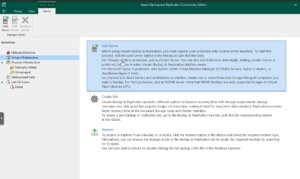
Virtual Infrastructure -> Add Server
This procedure is consistent with the established protocol for incorporating nodes from other virtualization platforms that are compatible with Veeam.
Afterwards, Veeam shows you a selection of possible and supported Hypervisors:
- VM vSphere

- Microsoft Hyper-V
- Nutanix AHV
- RedHat Virtualization
- Oracle Virtualization Manager
- Proxmox VE
In this case we simply choose Proxmox VE and proceed the setup wizard.
During the next steps in the setup wizard, the authentication details, the hostname or IP address of the target Proxmox VE server and also a snapshot storage of the Proxmox VE server must be defined.
Hint: When it comes to the authentication details, take care to use functional credentials for the SSH service on the Proxmox VE server. If you usually use the root@pam credentials for the web interface, you simply need to prompt root to Veeam. Veeam will initiate a connection to the system over the ssh protocol.
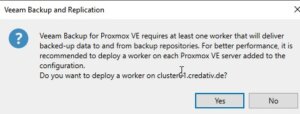
Usage
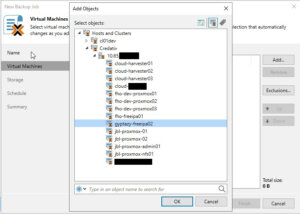
As a result, this does not only simplify the operator’s work when working with different servers and clusters but also provides finally the opportunity for cross-hypervisor-recoveries.
Creating Backup Jobs
Creating a new backup job for a single VM or even multiple VMs in a Proxmox environment is as simple and exactly the same way, like you already know for other hypervisors. However, let us have a quick summary about the needed tasks:
Open the Veeam Backup & Replication console on your backup server or management workstation. To start creating a backup job, navigate to the Home tab and click on Backup Job, then select Virtual machine from the drop-down menu.
When the New Backup Job wizard opens, you will need to enter a name and a description for the backup job. Click Next to proceed to the next step. Now, you will need to select the VMs that you want to back up. Click Add in the Virtual Machines step and choose the individual VMs or containers like folders, clusters, or entire hosts that you want to include in the backup. Once you have made your selection, click Next.
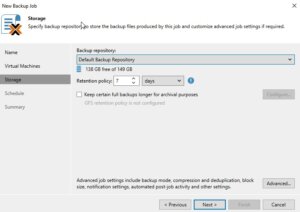
If you have configured multiple backup proxies, the next step allows you to specify which one to use. If you are not sure or if you prefer, you can let Veeam Backup & Replication automatically select the best proxy for the job. Click Next after making your choice.
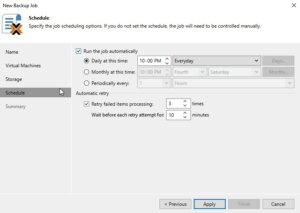
Review all the settings on the summary page to ensure they are correct. If everything looks good, click Finish to create the backup job.
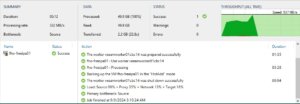
If you want to run the backup job immediately for ensuring everything works as expected, you can do so by right-clicking on the job and selecting Start. Alternatively, you can wait for the scheduled time to trigger the job automatically.
Restoring an entire VM
The restore and replication process for a full VM restore remains to the standard procedures. However, it now includes the significant feature of cross-hypervisor restore. This functionality allows for the migration of VMs between different hypervisor types without compatibility issues. For example, when introducing Proxmox VE into a corporate setting, operators can effortlessly migrate VMs from an existing hypervisor to the Proxmox VE cluster. Should any issues arise during the testing phase, the process also supports the reverse migration back to the original hypervisor. Let us have a look at the details.
Open the Veeam Backup & Replication console on your backup server or management workstation. To start creating a backup job, navigate to the Home tab and click on Backup Job, then select Virtual machine from the Disk menu.
Choose the Entire VM restore option, which will launch the wizard for restoring a full virtual machine. The first step in the wizard will ask you to select a backup from which you want to restore. You will see a list of available backups; select the one that contains the VM you wish to restore and proceed to the next step by clicking Next.
Now, you must decide on the restore point. Typically, this will be the most recent backup, but you may choose an earlier point if necessary. After selecting the restore point, continue to the next step.
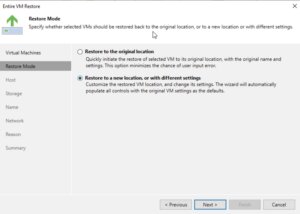
In the next step, you will have options regarding the power state of the VM after the restoration. You can choose to power on the VM automatically or leave it turned off, depending on your needs.
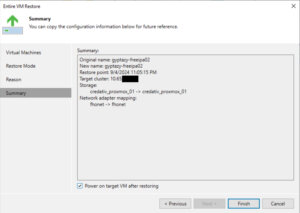
The restoration process will begin, and its progress can be monitored within the Veeam Backup & Replication console. Depending on the size of the VM and the performance of your backup storage and network, the restoration can take some time.
File-Level-Restore
Open the Veeam Backup & Replication console on your backup server or management workstation. To start creating a backup job, navigate to the Home tab and click on Backup Job, then select Virtual machine from the Disk menu.
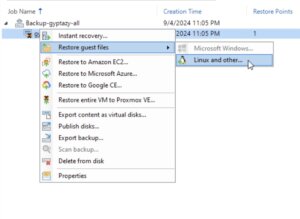
Choose the restore point that you want to use for the file-level restore. This is typically the most recent backup, but you can select an earlier one if needed. After picking the restore point, click Next to continue.
At this stage, you may need to choose the operating system of the VM that you are restoring files from. This is particularly important if the backup is of a different OS than the one on the Veeam Backup & Replication server because it will determine the type of helper appliance required for the restore.
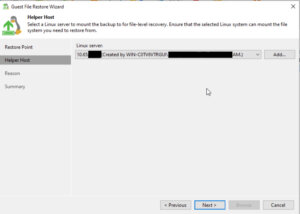
Once the helper appliance is ready, you will be able to browse the file system of the backup. Navigate through the backup to locate the files or folders you wish to restore.
After selecting the files or folders for restoration, you will be prompted to choose the destination where you want to restore the data. You can restore to the original location or specify a new location, depending on your requirements.
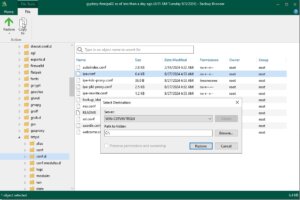
The file-level restore process will start, and you can monitor the progress within the Veeam Backup & Replication console. The time it takes to complete the restore will depend on the size and number of files being restored, as well as the performance of your backup storage and network.
Conclusion
Summarising all the things, the latest update to Veeam introduces a very important and welcomed integration with Proxmox VE, filling a significant gap for enterprises that have adopted this open-source virtualization platform. By enabling direct backups and restores of entire VMs across different hypervisors without the need for in-VM agents, Veeam now offers unparalleled flexibility and simplicity in managing mixed environments. This advancement not only streamlines operations and enhances data protection strategies but also empowers organizations to easily migrate and evaluate new open-source virtualization platforms like Proxmox VE with minimal risk. It is great to see that more and more companies are putting efforts into supporting open-source solutions which underlines the ongoing importance of open-source based products in enterprises.
Additionally, for those starting fresh with Proxmox, the Proxmox Backup Server remains a viable open-source alternative and you can find our blog post about configuring the Proxmox Backup Server right here. Overall, this update represents a significant step forward in unifying virtualization and backup infrastructures, offering both versatility and ease of integration.
We are always here to help and assist you with further consulting, planning, and integration needs. Whether you are exploring new virtualization platforms, optimizing your current infrastructure, or looking for expert guidance on your backup strategies, our team is dedicated to ensuring your success every step of the way. Do not hesitate to reach out to us for personalized support and tailored solutions to meet your unique requirements in virtualization- or backup environments.
Congratulations to the Debian Community
The Debian Project just released version 11 (aka “bullseye”) of their free operating system. In total, over 6,208 contributors worked on this release and were indispensable in making this launch happen. We would like to thank everyone involved for their combined efforts, hard work, and many hours pent in recent years building this new release that will benefit the entire open source community.
We would also like to acknowledge our in-house Debian developers who contributed to this effort. We really appreciate the work you do on behalf of the community and stand firmly behind your contributions.
What’s New in Debian 11 Bullseye
Debian 11 comes with a number of meaningful changes and enhancements. The new release includes over 13,370 new software packages, for a total of over 57,703 packages on release. Out of these, 35,532 packages have been updated to newer versions, including an update in the kernel from 4.19 in “buster” to 5.10 in bullseye.
Bullseye expands on the capabilities of driverless printing with Common Unix Printing System (CUPS) and driverless scanning with Scanner Access Now Easy (SANE). While it was possible to use CUPS for driverless printing with buster, bullseye comes with the package ipp-usb, which allows a USB device to be treated as a network device and thus extend driverless printing capabilities. SANE connects to this when set up correctly and connected to a USB port.
As in previous releases, Debian 11 comes with a Debian Edu / Skolelinux version. Debian Edu has been a complete solution for schools for many years. Debian Edu can provide the entire network for a school and then only users and machines need to be added after installation. This can also be easily managed via the web interface GOsa².
Debian 11 bullseye can be downloaded here.
https://www.debian.org/devel/debian-installer/index.en.html
For more information and greater technical detail on the new Debian 11 release, please refer to the official release notes on Debian.org
https://www.debian.org/releases/bullseye/amd64/release-notes/.
Contributions by Instaclustr Employees
Our Debian roots run deep here. credativ, which was acquired by Instaclustr in March 2021, has always been an active part of the Debian community and visited every DebConf since 2004. Debian also serves as the operating system at the heart of the Instaclustr Managed Platform.
For the release of Debian 11, our team has taken over various responsibilities in the community. Our contributions include:
- 90% of the PostgreSQL packaging of the new release Maintenance work on various packages
- Support as Debian-Sys-Admin
- Contributions to Debian Edu/Skolelinux
- Development work on kernel images
- Development work on cloud images
- Development work for various Debian backports
- Work on salsa.debian.org
Many of our colleagues have made significant contributions to the current release, including:
- Adrian Vondendriesch
- Alexander Wirt (Formorer)
- Bastian Blank (waldi)
- Christoph Berg (Myon)
- Dominik George (natureshadow)
- Felix Geyer (fgeyer)
- Martin Zobel-Helas (zobel)
- Michael Banck (azeem)
- Michael Meskes (feivel)
- Noël Köthe (Noel)
- Sven Bartscher (kritzefitz)
How to Upgrade
Given that Debian 11 bullseye is a major release, we suggest that everyone running on Debian 10 buster upgrade. The main steps for an upgrade include:
- Make sure to backup any data that should not get lost and prepare for recovery
- Remove non-Debian packages and clean up leftover files and old versions
- Upgrade to latest point release
- Check and prepare your APT source-list files by adding the relevant Internet sources or local mirrors
- Upgrade your packages and then upgrade your system
You can find a more detailed walkthrough of the upgrade process in the Debian documentation.
All existing credativ customers who are running a Debian-based installation are naturally covered by our service and support and are encouraged to reach out.
If you are interested in upgrading from your old Debian version, or if you have questions with regards to your Debian infrastructure, do not hesitate to drop us an email or contact us at info@credativ.de.
Or, you can get started in minutes with any one of these open source technologies like Apache Cassandra, Apache Kafka, Redis, and OpenSearch on the Instaclustr Managed Platform. Sign up for a free trial today.
100% Open Source – 100% Cost Control
The PostgreSQL® Competence Center of the credativ Group announces the creation of a new comprehensive service and support package that includes all services necessary for the operation of PostgreSQL® in enterprise environments. This new offering will be available starting August 1st, 2020.
“Motivated by the requirements of many of our customers, we put together a new and comprehensive PostgreSQL® service package that meets all the requirements for the operation of PostgreSQL® in enterprise environments.”, says Dr. Michael Meskes, managing director of the credativ Group.
“In particular, this package focuses on true open source support, placing great emphasis on the absence of any proprietary elements in our offer. Despite this, our service package still grants all of the necessary protection for operation in business-critical areas. Additionally, with this new offering, the number of databases operated within the company’s environment does not matter. As a result, credativ offers 100% cost control while allowing the entire database environment to be scaled as required.”
Database operation in enterprise environments places very high demands on the required service and support. Undoubtedly an extremely powerful, highly scalable, and rock-solid relational database is the basis for secure and high-performance operation.
However, a complete enterprise operating environment consists of much more than just the pure database; one needs holistic lifecycle management. Major and Minor version upgrades, migrations, security, services, patch management, and Long-Term Support (LTS) are just a few essential factors. Additionally, staying up to date also requires continuous regular training and practice.
Services for the entire operating environment
Beyond the database itself, one also needs a stable and highly scalable operating environment providing all necessary Open Source tools for PostgreSQL and meeting all requirements regarding high availability, security, performance, database monitoring, backups, and central orchestration of the entire database infrastructure. These tools include the open-source versions of numerous PostgreSQL related project packages, such as pgAdmin, pgBadger, pgBackrest, Patroni, but also the respective operating system environment and popular projects like Prometheus and Grafana, or even cloud infrastructures based on Kubernetes.
Just as indispensable as the accurate functioning of the database is smooth interaction with any components connected with the database. Therefore it is important to include and consider these components as well. Only when all aspects, such as operating system, load balancer, web server, application server, or PostgreSQL cluster solutions, work together, will the database achieve optimal performance.
This new support package is backed up by continuous 24×7 enterprise support, with guaranteed Service Level Agreements and all necessary services for the entire database environment, including a comprehensive set of open-source tools commonly used in today’s enterprise PostgreSQL environments. All of these requirements are covered by the PostgreSQL Enterprise package from credativ and are included within the scope of services. The new enterprise service proposal is offered at an annual flat rate, additionally simplifying costs and procurement.
About credativ
The credativ Group is an independent consulting and services company with primary locations in Germany, the United States, and India.
Since 1999, credativ has focused entirely on the planning and implementation of professional business solutions using Open Source software. Since May 2006, credativ operates the Open Source Support Center (OSSC), offering professional 24×7 enterprise support for numerous Open Source projects.
In addition, our PostgreSQL Competence Center of credativ provides a dedicated database team a comprehensive service for the PostgreSQL object-relational database eco-system.
This article was originally written by Philip Haas.
Open Source Summit is the world’s largest, all-encompassing open source conference. Topics such as the latest infrastructure software, development on the Linux kernel and current works in open source communities are discussed. Until now, open source databases were a missing part of the conference program.
However, databases such as PostgreSQL® or Apache Cassandra are one of the most important pillars in modern open source infrastructures.
Together with the Linux Foundation, we are pleased to announce that this year’s Open Source Summit North America and Europe each will have their own database track.
Together with Sunil Kamath (Microsoft) and Divya Bhargov (Pivotal), our Managing Director Dr. Michael Meskes forms the program committee for the new track of the event.
Dr. Michael Meskes comments this in his blog post at the Linux Foundation as follows:
“The open source database track will feature topics specific to databases themselves and their integration to the computing backbone for applications. The track will focus on databases of all kinds, as long as they are open source, and any deployment and integration topics.”
The complete blog post of the Linux Foundation can be found here.
The Linux Foundation and the program committee are looking forward to plenty of submissions for this track. Presentations can be submitted until 16 February (North America) and 14 June (Europe).
This year’s Open Source Summit North America will take place in Austin, Texas. Whereas the Open Source Summit Europe will be hosted in Dublin, Ireland. Both events are once again backed by credativ with a sponsorship.
This article was originally written by Philip Haas.
The PostgreSQL® Global Development Group (PGDG) has released version 12 of the popular free PostgreSQL® database. As our article for Beta 4 has already indicated, a number of new features, improvements and optimizations have been incorporated into the release. These include among others:
Optimized disk space utilization and speed for btree indexes
btree-Indexes, the default index type in PostgreSQL®, has experienced some optimizations in PostgreSQL® 12.
btree indexes used to store duplicates (multiple entries with the same key values) in an unsorted order. This has resulted in suboptimal use of physical representation in these indexes. An optimization now stores these multiple key values in the same order as they are physically stored in the table. This improves disk space utilization and the effort required to manage corresponding btree type indexes. In addition, indexes with multiple indexed columns use an improved physical representation so that their storage utilization is also improved. To take advantage of this in PostgreSQL® 12, however, if they were upgraded to the new version using pg_upgrade via a binary upgrade, these indexes must be recreated or re-indexed.
Insert operations in btree indexes are also accelerated by improved locking.
Improvements for pg_checksums
credativ has contributed an extension for pg_checksums that allows to enable or disable block checksums in stopped PostgreSQL® instances. Previously, this could only be done by recreating the physical data representation of the cluster using initdb.
pg_checksums now has the option to display a status history on the console with the --progress parameter. The corresponding code contributions come from the colleagues Michael Banck and Bernd Helmle.
Optimizer Inlining of Common Table Expressions
Up to and including PostgreSQL® 11, the PostgreSQL® Optimizer was unable to optimize common table expressions (also called CTE or WITH queries). If such an expression was used in a query, the CTE was always evaluated and materialized first before the rest of the query was processed. This resulted in expensive execution plans for more complex CTE expressions. The following generic example illustrates this. A join is given with a CTE expression that filters all even numbers from a numeric column:
WITH t_cte AS (SELECT id FROM foo WHERE id % 2 = 0) SELECT COUNT(*) FROM t_cte JOIN bar USING(id);
In PostgreSQL® 11, using a CTE always leads to a CTE scan that materializes the CTE expression first:
EXPLAIN (ANALYZE, BUFFERS) WITH t_cte AS (SELECT id FROM foo WHERE id % 2 = 0) SELECT COUNT(*) FROM t_cte JOIN bar USING(id) ;
QUERY PLAN
─────────────────────────────────────────────────────────────────────────────────────────────────────────────────────────
Aggregate (cost=2231.12..2231.14 rows=1 width=8) (actual time=48.684..48.684 rows=1 loops=1)
Buffers: shared hit=488
CTE t_cte
-> Seq Scan on foo (cost=0.00..1943.00 rows=500 width=4) (actual time=0.055..17.146 rows=50000 loops=1)
Filter: ((id % 2) = 0)
Rows Removed by Filter: 50000
Buffers: shared hit=443
-> Hash Join (cost=270.00..286.88 rows=500 width=0) (actual time=7.297..47.966 rows=5000 loops=1)
Hash Cond: (t_cte.id = bar.id)
Buffers: shared hit=488
-> CTE Scan on t_cte (cost=0.00..10.00 rows=500 width=4) (actual time=0.063..31.158 rows=50000 loops=1)
Buffers: shared hit=443
-> Hash (cost=145.00..145.00 rows=10000 width=4) (actual time=7.191..7.192 rows=10000 loops=1)
Buckets: 16384 Batches: 1 Memory Usage: 480kB
Buffers: shared hit=45
-> Seq Scan on bar (cost=0.00..145.00 rows=10000 width=4) (actual time=0.029..3.031 rows=10000 loops=1)
Buffers: shared hit=45
Planning Time: 0.832 ms
Execution Time: 50.562 ms
(19 rows)
This plan first materializes the CTE with a sequential scan with a corresponding filter (id % 2 = 0). Here no functional index is used, therefore this scan is correspondingly more expensive. Then the result of the CTE is linked to the table bar by Hash Join with the corresponding Join condition. With PostgreSQL® 12, the optimizer now has the ability to inline these CTE expressions without prior materialization. The underlying optimized plan in PostgreSQL® 12 will look like this:
EXPLAIN (ANALYZE, BUFFERS) WITH t_cte AS (SELECT id FROM foo WHERE id % 2 = 0) SELECT COUNT(*) FROM t_cte JOIN bar USING(id) ;
QUERY PLAN
───────────────────────────────────────────────────────────────────────────────────────────────────────────────────────────────────────────
Aggregate (cost=706.43..706.44 rows=1 width=8) (actual time=9.203..9.203 rows=1 loops=1)
Buffers: shared hit=148
-> Merge Join (cost=0.71..706.30 rows=50 width=0) (actual time=0.099..8.771 rows=5000 loops=1)
Merge Cond: (foo.id = bar.id)
Buffers: shared hit=148
-> Index Only Scan using foo_id_idx on foo (cost=0.29..3550.29 rows=500 width=4) (actual time=0.053..3.490 rows=5001 loops=1)
Filter: ((id % 2) = 0)
Rows Removed by Filter: 5001
Heap Fetches: 10002
Buffers: shared hit=74
-> Index Only Scan using bar_id_idx on bar (cost=0.29..318.29 rows=10000 width=4) (actual time=0.038..3.186 rows=10000 loops=1)
Heap Fetches: 10000
Buffers: shared hit=74
Planning Time: 0.646 ms
Execution Time: 9.268 ms
(15 rows)
The advantage of this method is that there is no initial materialization of the CTE expression. Instead, the query is executed directly with a Join. This works for all non-recursive CTE expressions without side effects (for example, CTEs with write statements) and those that are referenced only once per query. The old behavior of the optimizer can be forced with the WITH ... AS MATERIALIZED ... directive.
Generated Columns
Generated Columns in PostgreSQL® 12 are materialized columns, which calculate a result based on expressions using existing column values. These are stored with the corresponding result values in the tuple. The advantage is that there is no need to create triggers for subsequent calculation of column values. The following simple example illustrates the new functionality using a price table with net and gross prices:
CREATE TABLE preise(netto numeric,
brutto numeric GENERATED ALWAYS AS (netto * 1.19) STORED);
INSERT INTO preise VALUES(17.30);
INSERT INTO preise VALUES(225);
INSERT INTO preise VALUES(247);
INSERT INTO preise VALUES(19.15);
SELECT * FROM preise;
netto │ brutto
───────┼─────────
17.30 │ 20.5870
225 │ 267.75
247 │ 293.93
19.15 │ 22.7885
(4 rows)
The column brutto is calculated directly from the net price. The keyword STORED is mandatory. Of course, indexes can also be created on Generated Columns, but they cannot be part of a primary key. Furthermore, the SQL expression must be unique, i.e. it must return the same result even if the input quantity is the same. Columns declared as Generated Columns cannot be used explicitly in INSERT or UPDATE operations. If a column list is absolutely necessary, the corresponding value can be indirectly referenced with the keyword DEFAULT.
Omission of explicit OID columns
Explicit OID columns have historically been a way to create unique column values so that a table row can be uniquely identified database-wide. However, for a long time PostgreSQL® has only created these explicitly and considered their basic functionality obsolete. With PostgreSQL® the possibility to create such columns explicitly is now finally abolished. This means that it will no longer be possible to specify the WITH OIDS directive for tables. System tables that have always referenced OID objects uniquely will now return OID values without explicitly specifying OID columns in the result set. Especially older software, which handled catalog queries carelessly, could get problems with a double column output.
Moving recovery.conf to postgresql.conf
Up to and including PostgreSQL® 11, database recovery and streaming replication instances were configured via a separate configuration file recovery.conf.
With PostgreSQL® 12, all configuration work done there now migrates to postgresql.conf. The recovery.conf file is no longer required. PostgreSQL® 12 refuses to start as soon as this file exists. Whether recovery or streaming standby is desired is now decided either by a recovery.signal file (for recovery) or by a standby.signal file (for standby systems). The latter has priority if both files are present. The old parameter standby_mode, which controlled this behavior since then, has been removed.
For automatic deployments of high-availability systems, this means a major change. However, it is now also possible to perform corresponding configuration work almost completely using the ALTER SYSTEM command.
REINDEX CONCURRENTLY
With PostgreSQL® 12 there is now a way to re-create indexes with as few locks as possible. This greatly simplifies one of the most common maintenance tasks in very write-intensive databases. Previously, a combination of CREATE INDEX CONCURRENTLY and DROP INDEX CONCURRENTLY had to be used. In doing so, it was also necessary to ensure that index names were reassigned accordingly, if required.
The release notes give an even more detailed overview of all new features and above all incompatibilities with previous PostgreSQL® versions.
Yesterday, the fourth beta of the upcoming PostgreSQL®-major version 12 was released.
Compared to its predecessor PostgreSQL® 11, there are many new features:
- Performance improvements for indexes: btree indexes now manage space more efficiently. The REINDEX command now also supports CONCURRENTLY, which was previously only possible with new indexes.
- WITH queries are now embedded in the main query and thus optimized much better by the planner. Previously, WITH queries were always executed independently.
- The native partitioning was further improved. Foreign keys can now also reference partitioned tables. Maintenance commands such as ATTACH PARTITION no longer require an exclusive table lock.
- The support of page checksums and the tool pg_checksums was further improved, also with substantial cooperation by credativ.
- It is now possible to integrate additional storage engines. The “zheap”, which is still under development, will be based on this, which promises more compact data storage with less bloat.
Of course, PostgreSQL® 12 will be tested using sqlsmith, the SQL “fuzzer” from our colleague Andreas Seltenreich. Numerous bugs in different PostgreSQL® versions were found with sqlsmith by using randomly generated SQL queries.
Debian and Ubuntu packages for PostgreSQL® 12 are going to be published on apt.postgresql.org with credativ’s help. This work will be handled by our colleague Christoph Berg.
The release of PostgreSQL® 12 is expected in the next weeks.
This week version 1.3 of our PostgreSQL® appliance Elephant Shed was released.
The highlight of the new version is support for Red Hat Enterprise Linux 7 and CentOS 7. As is already the case for Debian, the appliance heavily relies on the postgresql-common infrastructure which was previously ported to RPM.
The well-known PostgreSQL® RPM packages from yum.postgresql.org are integrated into the system via pg_createcluster and can be administrated from the Elephant Shed web interface.
All other Elephant Shed components like pgAdmin4, Grafana, Prometheus, pgbackrest, Cockpit or shellinabox work in the same way as in the Debian version of the appliance. Only the SELinux functionality has to be deactivated in order to run pgAdmin4 and shellinabox as their packages do not support this.
Besides the port to RPM the appliance infrastructure was updated. The Prometheus node-exporter is now available in version 0.16 in which many metric names were adjusted to the Prometheus naming scheme. The Grafana dashboard was updated accordingly. The Apache configuration was switched from authnz_pam to authnz_external as the former is not available on CentOS and stable functionality could not longer be guaranteed on Debian Buster.
The next items on the Elephant-Shed roadmap are the integration of the REST-API in order to control particular components, as well as multi-host support so that several Elephant-Shed instances can be controlled simultaneously.
An overhaul of the user interface is planned as well.
The updated packages are available for download at packages.credativ.com. If Elephant-Shed was installed already, the updates are provided via apt as usual.
The open-source PostgreSQL® appliance Elephant-Shed is developed by credativ and is increasingly popular, as the most important compontents for the administration of PostgreSQL® servers are already included. Adjustments and extensions can be done at any time.
Comprehensible technical support for Elephant-Shed is offered by credativ including guaranteed service-level agreements and optional 365 days and 24/7 hours.
Today PostgreSQL® version 11 was released. The new release brings improvements in many areas.
Since version 9.6 query plans can be executed on multiple CPU cores in parallel, this is now supported for other plan types, especially the creation of B-tree indexes. Sequential scans and UNION queries have also been improved.
Brand new is the possibility to optimize queries via Just-in-Time Compilation (JIT). When PostgreSQL® is compiled, the source code is stored as LLVM bit code. When executing a query whose planner cost exceeds a limit, libllvm then translates this bit code into native machine code specifically for that query. Since all used data types etc. are known in advance, the machine code eliminates all case distinctions that are generally necessary. The feature is disabled by default and can be enabled with “SET jit = on;”. In PostgreSQL® 12 it should then be active by default.
Until now only functions could be defined on SQL level. New are now procedures which can manage BEGIN/COMMIT independently. Batch operations can now be completely transferred to the database side.
Table Partitioning section has been further improved to support hash partitioning. Integration with partitions using postgres_fdw has also been improved. It is now possible to create a default partition that holds data that does not fall into any of the existing partitions.
This Amp goes to 11!
Other improvements include the ability to add columns with default values to tables without having to rewrite the table completely. “Covering Indexes” allows more index accesses than “Index Only Scan”. Window functions now also support the RANGE and GROUPS keywords.
More information can be found in the release announcement of the PostgreSQL® project.
Next week the PGConf.EU will take place in Lisbon. We from credativ are present with a booth and celebrate the PostgreSQL® release with our “This Amp goes to 11” T-shirt.
The shirt is available for free at our booth. If you don’t attend the conference, you can order a shirt. The profits will be donated to the PostgreSQL® project.
The credativ PostgreSQL® Appliance is now available for download as a completely free Open Source solution. The new appliance called ‘Elephant Shed PostgreSQL® Appliance‘ offers a tremendous ease of use for enterprise PostgreSQL® operations. The long-term maintenance of the appliance will be handled by the PostgreSQL® experts of credativ. Prepared images for the major cloud and virtualization platforms are already in work and will be released soon for VMWare, Virtualbox, Vagrant and for the cloud platforms Microsoft Azure, Amazon Web Services and Google Cloud Platform.
Elephant Shed builds on proven components, which are published exclusively under recognized Open Source licenses. These tools are an effective support for the management of a PostgreSQL® server. All components used are pre-installed and integrated into the integral automation system. The majority of these tools can be used via a comfortable web interface.
Service and Support
For Elephant Shed, credativ offers comprehensive technical support with guaranteed service level agreements, which is also available 24 hours a day, 365 days a year. Support during installation and integration, as well as an introduction to Elephant Shed is of course also part of credativ’s services.
Please do not hesitate to contact us if you have any questions about Elephant Shed and our service and support services.
For more information, please visit our Elephant Shed- project page and Github.
This article was originally written by Philip Haas.


